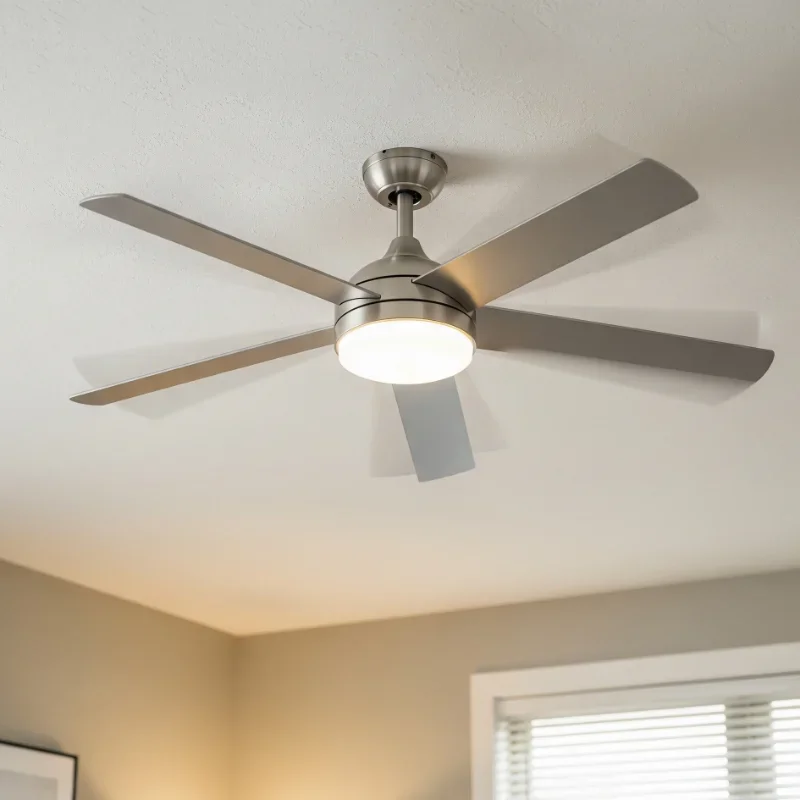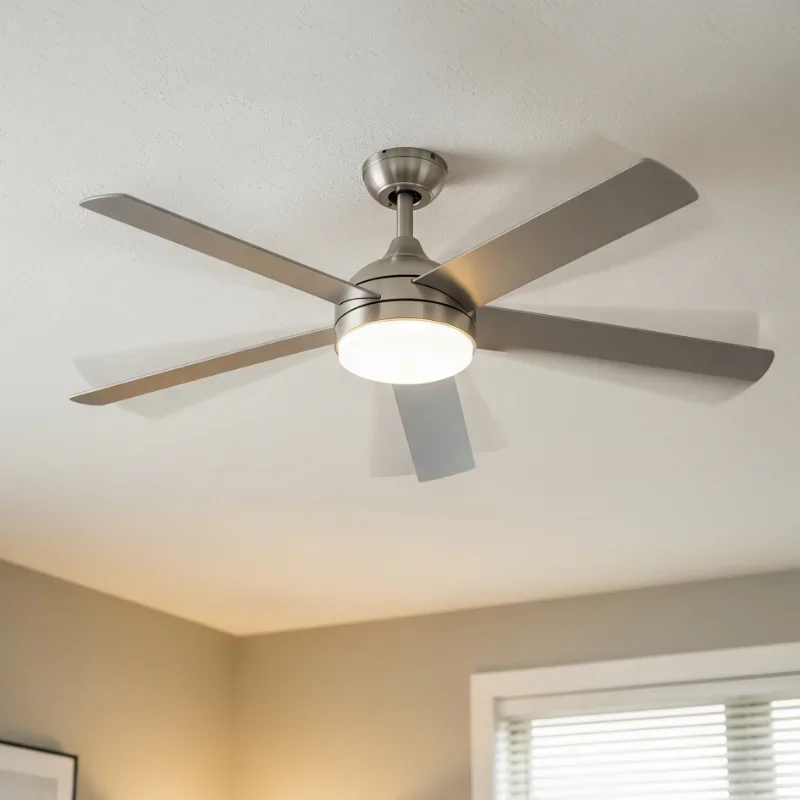How to Balance a Ceiling Fan for Smooth Operation
Fix your wobbly ceiling fan with easy DIY balancing techniques. Learn to identify problems and achieve smooth, quiet operation fast.
Oh boy, there's nothing quite like lying in bed, trying to catch some Z's, when your ceiling fan sounds like a helicopter attempting an emergency landing in your bedroom! If you've been wondering about "How to Balance a Ceiling Fan for Smooth Operation," you've probably already experienced the joy of a wobbly fan that makes you question whether it's cooling you down or planning to take flight. Trust me, I've been there, staring up at that spinning menace, wondering if today's the day it finally breaks free and goes on an adventure.
Here's the deal: a wobbling ceiling fan isn't just annoying; it's like having a really bad drummer in your house who never stops practicing. The constant shake, rattle, and roll can loosen screws, wear out the motor, and eventually turn your trusty fan into an expensive ceiling decoration. But before you call in the cavalry (or worse, decide to live with it), let me tell you that fixing a wobbly fan is easier than teaching your cat to fetch. With a few simple tools and some patience, you'll have that fan running smoother than a jazz saxophone solo!
Understanding Ceiling Fan Wobble: The Shaky Truth
Before we dive into fixing your fan's dance moves, let's understand why it's doing the wobble in the first place. Knowledge is power, and in this case, it's the power to stop feeling like you're living under a malfunctioning helicopter.
Common Causes of Fan Wobble
Your ceiling fan might be wobbling for several reasons, and no, it's not trying to communicate with you in Morse code:
Unbalanced blades: Like a bad haircut, even small differences matter
Loose screws: Everything needs to be snug as a bug
Warped blades: Heat and humidity can be real troublemakers
Dirty blades: Dust bunnies throwing off the balance
Bent blade brackets: From overzealous cleaning or installation mishaps
Improper installation: Sometimes it's been wrong from day one
Types of Wobble: Diagnosing the Dance
Not all wobbles are created equal, folks. Understanding your fan's particular shimmy helps target the fix:
Side-to-side wobble: Usually blade-related
Up-and-down bounce: Often mounting issues
Circular wobble: Could be motor or blade alignment
Intermittent wobble: Loose components that shift
Speed-dependent wobble: Different problems at different speeds
Safety First: Don't Become a Fan Casualty
Look, I know you're eager to get that fan balanced, but rushing in without proper prep is like trying to pet a cat backwards. It's not gonna end well. Let's talk safety, because explaining to your friends how you got knocked out by your own ceiling fan isn't a story you want to tell.
Pre-Balance Safety Checklist
Turn off the power: At the switch AND the breaker
Let it stop completely: Patience, grasshopper
Get a sturdy ladder: No wobbly chairs or stack of books
Have a buddy: Someone to hold the ladder and call 911 if needed
Clear the area: Move that coffee table you always stub your toe on
Gather your tools: Multiple trips up the ladder are asking for trouble
Essential Tools for the Job
Before you channel your inner handyperson, make sure you've got these tools ready:
Screwdriver set (both Phillips and flathead)
Measuring tape or ruler
Cleaning supplies (microfiber cloth and cleaner)
Blade balancing kit (or coins and tape)
Level (optional but helpful)
Pencil for marking
How to Balance a Ceiling Fan for Smooth Operation: The Step-by-Step Guide
Alright, it's showtime! Let's turn that wobbly disaster into a smooth operator. Follow these steps, and you'll be enjoying a peaceful breeze in no time.
Step 1: The Initial Inspection
First things first, play detective with your fan:
Turn on the fan at different speeds: Note when wobbling is worst
Observe the wobble pattern: Is it consistent or random?
Listen for unusual sounds: Clicking, grinding, or rattling
Check for visible issues: Bent blades, loose parts, or damage
Test the pull chain: Make sure it's not hitting the blades
Step 2: Clean Those Blades
You'd be amazed how often a good cleaning solves the problem. Dust accumulation is like your fan wearing an uneven winter coat:
Use a microfiber cloth or duster
Clean both sides of each blade thoroughly
Pay attention to the edges where dust loves to hide
Wipe down the motor housing while you're at it
Check if cleaning solved the wobble (fingers crossed!)
Step 3: Tighten Everything Up
Loose screws are the enemy of smooth operation. Time to show them who's boss:
What to tighten:
Blade screws (where blades attach to brackets)
Bracket screws (where brackets attach to motor)
Mounting screws (ceiling mount to electrical box)
Downrod connections (if applicable)
Light kit attachments (if present)
Pro tip: Don't overtighten! Snug is good, Hulk-strength is bad.
Step 4: Measure and Align the Blades
Getting scientific now! Misaligned blades are like a car with different-sized tires:
Measure from ceiling to blade tip: Use the same spot on each blade
Check all blades: They should be within 1/8 inch of each other
Gently bend brackets: If needed, to achieve uniform height
Measure blade pitch: Use a level against each blade
Ensure consistent angles: All blades should match
Step 5: The Balancing Act
Here's where we get into the nitty-gritty of "How to Balance a Ceiling Fan for Smooth Operation":
Method 1: The Balancing Kit
Use clip-on weights from a balancing kit
Start with one weight in the middle of a blade
Test each blade to find the problem child
Move weight along the blade to find sweet spot
Attach permanent weights once located
Method 2: The Coin Trick
Tape a nickel or quarter to a blade
Test the fan
Move coin to different blades and positions
Add or remove coins as needed
Replace with proper weights when balanced
Step 6: Fine-Tuning Your Success
Once you've got the major wobble under control, it's time for the finishing touches:
Run fan at all speeds to verify smoothness
Listen for any remaining unusual sounds
Make micro-adjustments as needed
Document weight placement for future reference
Pat yourself on the back!
Advanced Troubleshooting: When Basic Balancing Isn't Enough
Sometimes, despite your best efforts, that fan keeps doing the shimmy. Don't throw in the towel just yet! Let's explore some advanced solutions.
Blade Replacement Considerations
When blades are beyond salvation:
Warped beyond repair
Cracked or damaged
Different weights (mismatched set)
Previous repair attempts failed
Replacement tips:
Buy a complete matched set
Match the original specifications
Consider upgrading blade material
Keep old blades as templates
Motor and Mounting Issues
Sometimes the problem runs deeper than the blades:
Loose ceiling box: Needs reinforcement or replacement
Worn motor bearings: May require professional repair
Bent motor shaft: Usually means replacement time
Inadequate electrical box: Upgrade to fan-rated box
Building settling: May need mounting adjustment
Maintenance Tips: Keeping Your Fan Happy
An ounce of prevention is worth a pound of cure, or in this case, a smooth fan is worth a thousand wobble-free nights.
Regular Maintenance Schedule
Keep your fan running smoothly with routine care:
Monthly: Quick visual inspection
Bi-monthly: Dust the blades
Quarterly: Check and tighten screws
Annually: Deep clean and full inspection
As needed: Re-balance if wobble returns
Seasonal Considerations
Different seasons, different challenges:
Summer maintenance:
Higher usage means more frequent cleaning
Check for loosening from constant operation
Verify direction for cooling efficiency
Winter prep:
Reverse direction for heating assistance
Clean before seasonal switch
Check balance after direction change
Common Mistakes: Don't Be That Person
Learning from others' mistakes is way better than making your own. Here are the biggies to avoid:
The "Close Enough" Syndrome
"Eh, it's just wobbling a little" turns into "Why is my fan on the floor?" Real quick. Don't ignore minor wobbles; they always get worse.
Over-tightening Everything
Cranking those screws like you're assembling a space shuttle can:
Strip the threads
Crack blade material
Warp mounting brackets
Create new problems
Ignoring Weight Limits
Adding too much balancing weight is like putting a bowling ball on a bicycle wheel. Follow manufacturer guidelines!
DIY Blade Modifications
Sanding, cutting, or otherwise "fixing" blades usually makes things worse. Leave the engineering to the engineers.
When to Call a Professional: Know Your Limits
Sometimes you gotta wave the white flag and call in the pros. No shame in that game! Here's when to make the call:
Electrical issues beyond the fan
Ceiling box problems requiring reinforcement
Motor replacement needs
Persistent wobble despite all efforts
Any situation where you feel unsafe
Cost Considerations: Budget for Balance
Let's talk money, honey. Here's what you might spend:
DIY Costs:
Balancing kit: $5-15
New blade set: $20-80
Cleaning supplies: $10-20
Your time: Priceless (but probably 1-2 hours)
Professional Costs:
Service call: $75-150
Parts: Varies widely
Complete replacement: $150-500+
The Science Behind Fan Balance
Getting a bit nerdy here, but understanding the physics helps:
Centrifugal Force and You
When your fan spins, any weight imbalance creates centrifugal force that:
Increases with speed
Compounds small imbalances
Stresses mounting hardware
Creates that annoying wobble
Why Balance Matters
A balanced fan:
Runs more efficiently
Lasts longer
Makes less noise
Uses less energy
Reduces stress on your ceiling
Choosing Quality: Prevention Through Selection
If you're in the market for a new fan, here's how to avoid future wobbles:
Features to Look For
Precision-balanced blades
Quality motor construction
Sturdy mounting system
Good warranty coverage
Positive reviews mentioning stability
Red Flags to Avoid
Suspiciously cheap prices
Lightweight construction
Poor reviews citing wobbling
No balancing kit included
Unclear installation instructions
Conclusion
There you have it, everything you need to know about "How to Balance a Ceiling Fan for Smooth Operation"! Remember, a wobbling fan isn't just an annoyance; it's a problem waiting to get worse. With these techniques, you can transform that shaky overhead menace into the smooth, quiet breeze machine it was meant to be. Take your time, be methodical, and soon you'll be enjoying perfectly balanced air circulation that'll make you wonder why you waited so long to fix it!
Read next: How to Install a Ceiling Fan Like a Pro: Step-by-Step Guide
Frequently Asked Questions
Q1: How long does it take to balance a ceiling fan?
A: Usually 30-60 minutes, depending on the severity of the wobble.
Q2: Can I use any weight to balance my fan?
A: Stick to proper weights; coins work temporarily but aren't ideal long-term.
Q3: Why does my fan only wobble at high speed?
A: Higher speeds amplify small imbalances that aren't noticeable at lower speeds.
Q4: Should I oil my ceiling fan while balancing?
A: Only if manufacturer recommends it; most modern fans have sealed bearings.
Q5: Is it normal for fans to wobble slightly?
A: Minimal movement is okay, but visible wobbling should always be addressed.







